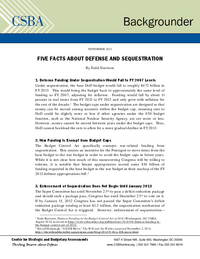
1. Defense Funding Under Sequestration Would Fall to FY 2007 Levels
Under sequestration, the base DoD budget would fall to roughly $472 billion in FY 2013. This would bring the budget back to approximately the same level of funding as FY 2007, adjusting for inflation. Funding would fall by about 11 percent in real terms from FY 2012 to FY 2013 and only grow with inflation for the rest of the decade.
The budget caps under sequestration are designed so that money can be moved among accounts within the budget cap, meaning cuts to DoD could be slightly more or less if other agencies under the 050 budget function, such as the National Nuclear Security Agency, are cut more or less. However, money cannot be moved between years under the budget caps. Thus, DoD cannot backload the cuts to allow for a more gradual decline in FY 2013.
2. War Funding Is Exempt from Budget Caps
The Budget Control Act specifically exempts war-related funding from sequestration. This creates an incentive for the Pentagon to move items from the base budget to the war budget in order to avoid the budget caps in future years. While it is not clear how much of this maneuvering Congress will be willing to tolerate, it is notable that Senate appropriators moved some $10 billion of funding requested in the base budget to the war budget in their markup of the FY 2012 defense appropriations bill.



























